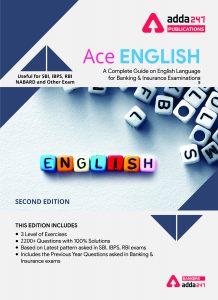Directions (1-10): In the following passage there are blanks, each of which has been numbered. These numbers are printed below the passage and against each, five words are suggested, one of which fits the blank appropriately. Find out the appropriate word in each case.
Q1. Confidence in the global economy is ____(1)___ improving, as evidenced by the bullish behaviour of financial markets and by increasingly positive comments from companies and policy makers over the past few weeks. While economists have generally argued in ____(2)____ of a robust recovery, both in the world economy and in financial markets, it is when investors get ____(3)___ bullish that the pessimistic case deserves more ____(4)____. Many of them believe that the current improvement in global conditions is just a blip and that the world faces years, if not decades, of “secular stagnation.” How ____(5)____ should we take these foreboding statements? The good news is that there is not much ____(6)___ of secular stagnation in global statistics. For the world economy as a whole, “new normal” since 2008 has not, in fact, been very ____(7)____ from the pre-crisis period. The average growth of the global economy, from 1988 to 2007, was 3.6 per cent according to the IMF’s Economic Outlook database. Its latest forecast for this year is the same — 3.6 per cent — although the IMF Managing Director hinted at a modest ____(8)____ this week. At first sight, this continuity from the pre-crisis decades seems ____(9)____ to square with the slowdown in economic activity in all major economies since 2008. The IMF expects only 2.2 per cent growth this year in developed countries compared with an average of 2.8 per cent during the two decades before the crisis. In the emerging economies, meanwhile, growth is ____(I0)____ at 4.8 per cent this year, slightly below the 4.9 per cent of the pre-crisis decades.
(a) heavily
(b) steadily
(c) tremendously
(d) highly
(e) regularly
Q2. Confidence in the global economy is ____(1)___ improving, as evidenced by the bullish behaviour of financial markets and by increasingly positive comments from companies and policy makers over the past few weeks. While economists have generally argued in ____(2)____ of a robust recovery, both in the world economy and in financial markets, it is when investors get ____(3)___ bullish that the pessimistic case deserves more ____(4)____. Many of them believe that the current improvement in global conditions is just a blip and that the world faces years, if not decades, of “secular stagnation.” How ____(5)____ should we take these foreboding statements? The good news is that there is not much ____(6)___ of secular stagnation in global statistics. For the world economy as a whole, “new normal” since 2008 has not, in fact, been very ____(7)____ from the pre-crisis period. The average growth of the global economy, from 1988 to 2007, was 3.6 per cent according to the IMF’s Economic Outlook database. Its latest forecast for this year is the same — 3.6 per cent — although the IMF Managing Director hinted at a modest ____(8)____ this week. At first sight, this continuity from the pre-crisis decades seems ____(9)____ to square with the slowdown in economic activity in all major economies since 2008. The IMF expects only 2.2 per cent growth this year in developed countries compared with an average of 2.8 per cent during the two decades before the crisis. In the emerging economies, meanwhile, growth is ____(I0)____ at 4.8 per cent this year, slightly below the 4.9 per cent of the pre-crisis decades.
(a) approval
(b) favour
(c) account
(d) side
(e) grace
Q3. Confidence in the global economy is ____(1)___ improving, as evidenced by the bullish behaviour of financial markets and by increasingly positive comments from companies and policy makers over the past few weeks. While economists have generally argued in ____(2)____ of a robust recovery, both in the world economy and in financial markets, it is when investors get ____(3)___ bullish that the pessimistic case deserves more ____(4)____. Many of them believe that the current improvement in global conditions is just a blip and that the world faces years, if not decades, of “secular stagnation.” How ____(5)____ should we take these foreboding statements? The good news is that there is not much ____(6)___ of secular stagnation in global statistics. For the world economy as a whole, “new normal” since 2008 has not, in fact, been very ____(7)____ from the pre-crisis period. The average growth of the global economy, from 1988 to 2007, was 3.6 per cent according to the IMF’s Economic Outlook database. Its latest forecast for this year is the same — 3.6 per cent — although the IMF Managing Director hinted at a modest ____(8)____ this week. At first sight, this continuity from the pre-crisis decades seems ____(9)____ to square with the slowdown in economic activity in all major economies since 2008. The IMF expects only 2.2 per cent growth this year in developed countries compared with an average of 2.8 per cent during the two decades before the crisis. In the emerging economies, meanwhile, growth is ____(I0)____ at 4.8 per cent this year, slightly below the 4.9 per cent of the pre-crisis decades.
(a) together
(b) wild
(c) extreme
(d) uniformly
(e) distributive
Q4. Confidence in the global economy is ____(1)___ improving, as evidenced by the bullish behaviour of financial markets and by increasingly positive comments from companies and policy makers over the past few weeks. While economists have generally argued in ____(2)____ of a robust recovery, both in the world economy and in financial markets, it is when investors get ____(3)___ bullish that the pessimistic case deserves more ____(4)____. Many of them believe that the current improvement in global conditions is just a blip and that the world faces years, if not decades, of “secular stagnation.” How ____(5)____ should we take these foreboding statements? The good news is that there is not much ____(6)___ of secular stagnation in global statistics. For the world economy as a whole, “new normal” since 2008 has not, in fact, been very ____(7)____ from the pre-crisis period. The average growth of the global economy, from 1988 to 2007, was 3.6 per cent according to the IMF’s Economic Outlook database. Its latest forecast for this year is the same — 3.6 per cent — although the IMF Managing Director hinted at a modest ____(8)____ this week. At first sight, this continuity from the pre-crisis decades seems ____(9)____ to square with the slowdown in economic activity in all major economies since 2008. The IMF expects only 2.2 per cent growth this year in developed countries compared with an average of 2.8 per cent during the two decades before the crisis. In the emerging economies, meanwhile, growth is ____(I0)____ at 4.8 per cent this year, slightly below the 4.9 per cent of the pre-crisis decades.
(a) weight
(b) meaning
(c) attraction
(d) notice
(e) attention
Q5. Confidence in the global economy is ____(1)___ improving, as evidenced by the bullish behaviour of financial markets and by increasingly positive comments from companies and policy makers over the past few weeks. While economists have generally argued in ____(2)____ of a robust recovery, both in the world economy and in financial markets, it is when investors get ____(3)___ bullish that the pessimistic case deserves more ____(4)____. Many of them believe that the current improvement in global conditions is just a blip and that the world faces years, if not decades, of “secular stagnation.” How ____(5)____ should we take these foreboding statements? The good news is that there is not much ____(6)___ of secular stagnation in global statistics. For the world economy as a whole, “new normal” since 2008 has not, in fact, been very ____(7)____ from the pre-crisis period. The average growth of the global economy, from 1988 to 2007, was 3.6 per cent according to the IMF’s Economic Outlook database. Its latest forecast for this year is the same — 3.6 per cent — although the IMF Managing Director hinted at a modest ____(8)____ this week. At first sight, this continuity from the pre-crisis decades seems ____(9)____ to square with the slowdown in economic activity in all major economies since 2008. The IMF expects only 2.2 per cent growth this year in developed countries compared with an average of 2.8 per cent during the two decades before the crisis. In the emerging economies, meanwhile, growth is ____(I0)____ at 4.8 per cent this year, slightly below the 4.9 per cent of the pre-crisis decades.
(a) easily
(b) seriously
(c) badly
(d) simply
(e) much
Q6. Confidence in the global economy is ____(1)___ improving, as evidenced by the bullish behaviour of financial markets and by increasingly positive comments from companies and policy makers over the past few weeks. While economists have generally argued in ____(2)____ of a robust recovery, both in the world economy and in financial markets, it is when investors get ____(3)___ bullish that the pessimistic case deserves more ____(4)____. Many of them believe that the current improvement in global conditions is just a blip and that the world faces years, if not decades, of “secular stagnation.” How ____(5)____ should we take these foreboding statements? The good news is that there is not much ____(6)___ of secular stagnation in global statistics. For the world economy as a whole, “new normal” since 2008 has not, in fact, been very ____(7)____ from the pre-crisis period. The average growth of the global economy, from 1988 to 2007, was 3.6 per cent according to the IMF’s Economic Outlook database. Its latest forecast for this year is the same — 3.6 per cent — although the IMF Managing Director hinted at a modest ____(8)____ this week. At first sight, this continuity from the pre-crisis decades seems ____(9)____ to square with the slowdown in economic activity in all major economies since 2008. The IMF expects only 2.2 per cent growth this year in developed countries compared with an average of 2.8 per cent during the two decades before the crisis. In the emerging economies, meanwhile, growth is ____(I0)____ at 4.8 per cent this year, slightly below the 4.9 per cent of the pre-crisis decades.
(a) evidence
(b) example
(c) sample
(d) clue
(e) information
Q7. Confidence in the global economy is ____(1)___ improving, as evidenced by the bullish behaviour of financial markets and by increasingly positive comments from companies and policy makers over the past few weeks. While economists have generally argued in ____(2)____ of a robust recovery, both in the world economy and in financial markets, it is when investors get ____(3)___ bullish that the pessimistic case deserves more ____(4)____. Many of them believe that the current improvement in global conditions is just a blip and that the world faces years, if not decades, of “secular stagnation.” How ____(5)____ should we take these foreboding statements? The good news is that there is not much ____(6)___ of secular stagnation in global statistics. For the world economy as a whole, “new normal” since 2008 has not, in fact, been very ____(7)____ from the pre-crisis period. The average growth of the global economy, from 1988 to 2007, was 3.6 per cent according to the IMF’s Economic Outlook database. Its latest forecast for this year is the same — 3.6 per cent — although the IMF Managing Director hinted at a modest ____(8)____ this week. At first sight, this continuity from the pre-crisis decades seems ____(9)____ to square with the slowdown in economic activity in all major economies since 2008. The IMF expects only 2.2 per cent growth this year in developed countries compared with an average of 2.8 per cent during the two decades before the crisis. In the emerging economies, meanwhile, growth is ____(I0)____ at 4.8 per cent this year, slightly below the 4.9 per cent of the pre-crisis decades.
(a) similar
(b) distinctive
(c) differing
(d) different
(e) identical
Q8. Confidence in the global economy is ____(1)___ improving, as evidenced by the bullish behaviour of financial markets and by increasingly positive comments from companies and policy makers over the past few weeks. While economists have generally argued in ____(2)____ of a robust recovery, both in the world economy and in financial markets, it is when investors get ____(3)___ bullish that the pessimistic case deserves more ____(4)____. Many of them believe that the current improvement in global conditions is just a blip and that the world faces years, if not decades, of “secular stagnation.” How ____(5)____ should we take these foreboding statements? The good news is that there is not much ____(6)___ of secular stagnation in global statistics. For the world economy as a whole, “new normal” since 2008 has not, in fact, been very ____(7)____ from the pre-crisis period. The average growth of the global economy, from 1988 to 2007, was 3.6 per cent according to the IMF’s Economic Outlook database. Its latest forecast for this year is the same — 3.6 per cent — although the IMF Managing Director hinted at a modest ____(8)____ this week. At first sight, this continuity from the pre-crisis decades seems ____(9)____ to square with the slowdown in economic activity in all major economies since 2008. The IMF expects only 2.2 per cent growth this year in developed countries compared with an average of 2.8 per cent during the two decades before the crisis. In the emerging economies, meanwhile, growth is ____(I0)____ at 4.8 per cent this year, slightly below the 4.9 per cent of the pre-crisis decades.
(a) reduce
(b) crash
(c) subside
(d) flop
(e) decline
Q9. Confidence in the global economy is ____(1)___ improving, as evidenced by the bullish behaviour of financial markets and by increasingly positive comments from companies and policy makers over the past few weeks. While economists have generally argued in ____(2)____ of a robust recovery, both in the world economy and in financial markets, it is when investors get ____(3)___ bullish that the pessimistic case deserves more ____(4)____. Many of them believe that the current improvement in global conditions is just a blip and that the world faces years, if not decades, of “secular stagnation.” How ____(5)____ should we take these foreboding statements? The good news is that there is not much ____(6)___ of secular stagnation in global statistics. For the world economy as a whole, “new normal” since 2008 has not, in fact, been very ____(7)____ from the pre-crisis period. The average growth of the global economy, from 1988 to 2007, was 3.6 per cent according to the IMF’s Economic Outlook database. Its latest forecast for this year is the same — 3.6 per cent — although the IMF Managing Director hinted at a modest ____(8)____ this week. At first sight, this continuity from the pre-crisis decades seems ____(9)____ to square with the slowdown in economic activity in all major economies since 2008. The IMF expects only 2.2 per cent growth this year in developed countries compared with an average of 2.8 per cent during the two decades before the crisis. In the emerging economies, meanwhile, growth is ____(I0)____ at 4.8 per cent this year, slightly below the 4.9 per cent of the pre-crisis decades.
(a) hard
(b) default
(c) difficult
(d) hit
(e) roughly
Q10. Confidence in the global economy is ____(1)___ improving, as evidenced by the bullish behaviour of financial markets and by increasingly positive comments from companies and policy makers over the past few weeks. While economists have generally argued in ____(2)____ of a robust recovery, both in the world economy and in financial markets, it is when investors get ____(3)___ bullish that the pessimistic case deserves more ____(4)____. Many of them believe that the current improvement in global conditions is just a blip and that the world faces years, if not decades, of “secular stagnation.” How ____(5)____ should we take these foreboding statements? The good news is that there is not much ____(6)___ of secular stagnation in global statistics. For the world economy as a whole, “new normal” since 2008 has not, in fact, been very ____(7)____ from the pre-crisis period. The average growth of the global economy, from 1988 to 2007, was 3.6 per cent according to the IMF’s Economic Outlook database. Its latest forecast for this year is the same — 3.6 per cent — although the IMF Managing Director hinted at a modest ____(8)____ this week. At first sight, this continuity from the pre-crisis decades seems ____(9)____ to square with the slowdown in economic activity in all major economies since 2008. The IMF expects only 2.2 per cent growth this year in developed countries compared with an average of 2.8 per cent during the two decades before the crisis. In the emerging economies, meanwhile, growth is ____(I0)____ at 4.8 per cent this year, slightly below the 4.9 per cent of the pre-crisis decades.
(a) highlighted
(b) depicted
(c) projected
(d) progressed
(e) assumed
Solutions
S1. Ans.(b)
S2. Ans.(b)
S3. Ans.(d)
S4. Ans.(e)
S5. Ans.(b)
S6. Ans.(a)
S7. Ans.(d)
S8. Ans.(e)
S9. Ans.(a)
S10. Ans.(c)




 English Language Quiz For Bank Foundatio...
English Language Quiz For Bank Foundatio...
 English Language Quiz For Bank Mains Exa...
English Language Quiz For Bank Mains Exa...


